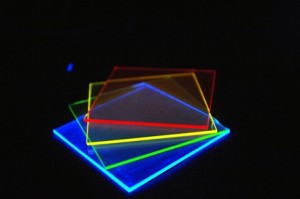We have much more to do and your continued support is needed now more than ever.
Overcoming Solar’s Challenges with a New Technology
A research team at the Massachusetts Institute of Technology has invented a cheaper method for harnessing solar energy that could ultimately power homes, campuses and office buildings through tinted windows.
Led by MIT Professor Marc Baldo, a team of three graduate students in the Department of Electrical Engineering and Computer Science spent two years identifying organic dyes that could efficiently absorb and spread energy across the surface of glass panes.
Applied in thin coats on ordinary glass, the dyes diffuse the sun’s beams to concentrate along the edges of the glass panel. Instead of covering a roof with expensive solar cells to power a building, Baldo says, only a small number of semiconductor devices along glass edges are needed.

“If you asked me before that paper came out, I would have said solar energy would be available and affordable in 10 years; now I might say five years,” says Kane Jennings, associate professor of chemical and biomolecular engineering at Vanderbilt University in Nashville, who is conducting his own research in solar technology.
“When I see the work that Baldo and those guys are doing, it gives me a lot of hope.”
Solar energy’s main drawback until now has been its expense. Solar semiconductor cells that collect rays and convert them to electricity are pricey to manufacture. At present, solar power comes in at about 20 cents a kilowatt/hour – twice the price of conventional electricity, according to George Douglas, spokesman for the Department of Energy’s National Renewable Energy Laboratory, based in Golden, Co.
Researchers in academia, industry and government are tackling the cost problem from two angles, Douglas says: designing innovations in solar cell manufacturing to lower their costs, and, like Baldo’s group, inventing ways to concentrate solar power to require fewer solar cells.
MIT’s team includes postdoctoral associate Shalom Goffri from MIT’s Research Laboratory of Electronics and graduate student researchers Michael Currie, Jon Mapel and Timothy Heide. As electrical engineers, the team was chosen for their individual background working with optical techniques for lasers and light emitting diodes.

MIT researchers decided to try again, this time adapting laser optical techniques to experiment with solar concentration.
Using a mixture of light-capturing dyes in specific ratios, the team found it could control light absorption and emission. The coated windows retain energy from sunrays, and direct it to the edges of the glass, where it stays in concentrated form.
“We made it so the light can travel a much longer distance,” Mapel said in a news release. “We were able to substantially reduce light transport losses, resulting in a tenfold increase in the amount of power converted by the solar cells.”
The team’s effort, sponsored by the U.S. Department of Energy’s Office of Science and the National Science Foundation, has spun off into a commercial venture.
Baldo and his students started their own company, Covalent Solar, to develop and commercialize the product. Baldo says he believes they will have a viable commercial product on the market in three years. There’s no word on the expected cost of the final product. The team is raising venture capital. Press reports from Beijing to the United Kingdom have given the project a boost of recognition. Last month, Discover magazine named their innovation one of the Top 100 Stories of 2008.
But the team has some challenges to overcome. The lifespan of the current dyes used is just three months. Baldo hopes to create a product that will last for decades.
Researchers say that may be no easy task.
“Stability problems are challenging, because it takes a long time to do those studies,” says Jennings, the Vanderbilt professor.
“If the dye molecules aren’t lasting, it’s going to take them awhile to figure that out,” Jennings says. “If you design something you think is going to last a few years, how will you know that unless you test it under the right conditions?”
See More:
UCSD Plants Solar Trees on Parking Structures: Campus Technology
What’s Hot on Campuses This Year: Solar Power: Chronicle of Higher Education
USF Sows the SEEDS of Renewable Energy: ClimateEdu




















